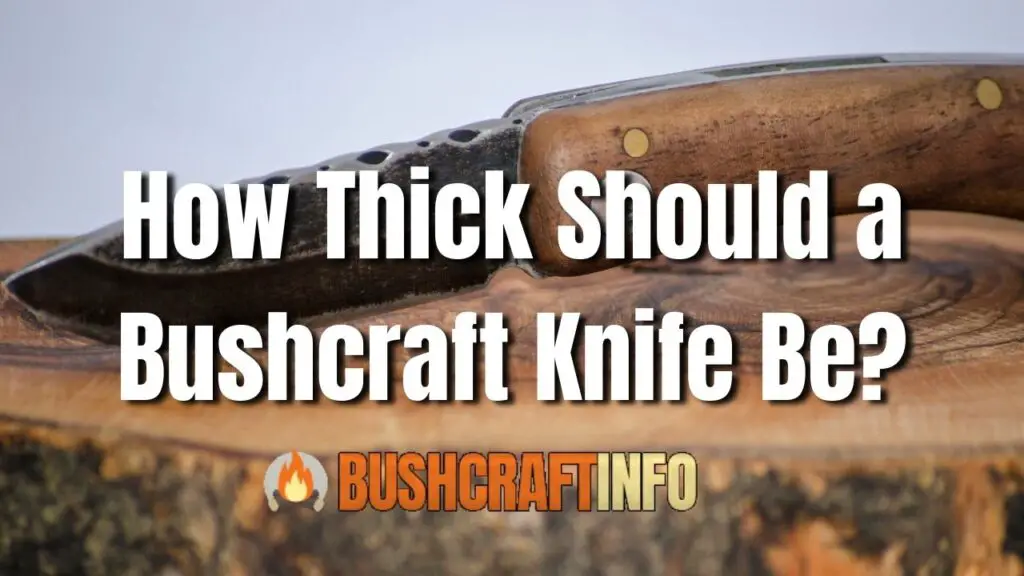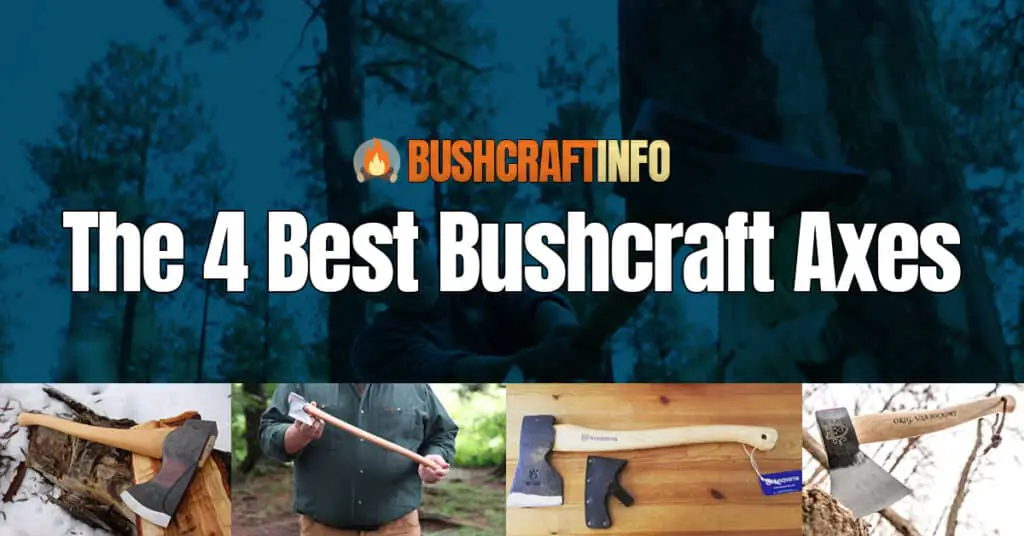If you are new to bushcraft knives, then, you might be wondering how thick a bushcraft knife should be.
The thickness of the bushcraft knife should be about 3/16 inches. This is a sweet spot between thick and thin blades, making the knife pretty much suitable for every application out there.
However, that’s not all, and there’s definitely a lot more to learn when it comes to knowing about the thickness of bushcraft knife blades. Luckily, you are in the right place because I have explained everything you are looking for in this article.
So, if you are interested in learning how thick should a bushcraft knife be along with some other interesting facts, then, I highly recommend you to keep on reading!

How Thick are Bushcraft Knives?
As mentioned earlier, the ideal thickness of the bushcraft knives should be about 3/16 inches. Now, you must be wondering why do we need knives with that much thickness. Well, your knife is going to go through a lot when you are out in the wilderness.
For example, you will be using it for batoning, clearing bushes, butchering, hunting, and a lot more activities. Under such conditions, the thickness of your knife plays an important role.
If you choose a thin knife then you can easily cut food items with it. But on the other side, you won’t be able to do other heavy-duty tasks with it. Even if you try to do something heavy with it, there will be a higher chance of damaging the blade of the knife.
However, if you carry a thicker knife, then, you can not only cut food items with it but it can help you in so many other tasks. Now, the question arises: why only 3/16 inches of thickness? Why am I not recommended other values than this one?
Well, the answer to this question is straightforward. The 3/16 inch is pretty much a sweet spot between not too thick and not too thin. If you choose a knife thicker than this range, then yeah, it will be more durable. But, along with its durability, it will get ridiculously heavy. A heavy knife will slow you down and tire you out quickly.
How thick should a knife spine be?
The next thing that you might be wondering is the thickness of the spine of a knife. The answer to this question depends on the applications of the knife. If you are using the knife mostly for carving activities, then, it should be around 0.35 mm thick.
However, knives that are used mainly for cooking-related activities i.e. butchering and cutting, etc should be around 0.45 mm. Besides that, there is another thing that you must keep in your mind.
The thickness of the spine of a knife depends upon the height of the knife too. If the knife is short and the spine is thicker then it will be completely out of balance.
Are thicker Bushcraft knives better?
Thicker knives are better for a few reasons. The first and the most obvious thing is that the thicker the blade of the knife is, the stronger it will be. Thicker knives perform very well in rough and tough situations and you can fully count on them because they will never break easily.
Besides that, thicker knives are also very good at cutting hard objects. That is why mostly bushcraft knives are thicker in nature because they can be used for batoning the wood for making fire, clearing bushes, etc.
However, thicker knives do have some drawbacks, which makes them not the perfect choice for every situation. The first thing that makes the thicker bushcraft not very useful is the thickness itself. It may be able to cut even harder objects, but it is not as fast as knives with thinner blades.
This means that you need to spend more time sharpening your knife rather than just cutting things. Another drawback of thicker knives is that they are heavier than their thinner counterparts. So, carrying a knife like this is going to make you feel tired after a while.
Thickness Does not Always Mean Durability
As mentioned a few times in the above article, thicker knives are usually stronger than thinner ones. However, this doesn’t necessarily mean the thickness of the knife is the only parameter to measure the durability of the blade.
Besides how thick the knife actually is, the composition of the knife matters a lot, and it is one of the key factors to look for. For example, I’ve already written an article on different types of steel used for making bushcraft knives.
This means that knives made from high carbon steel are going to be tougher than those made from low carbon steel. This is because the high-carbon steels contain higher amounts of chromium and nickel. These elements are responsible for giving the knife extra strength and toughness.
Besides that, if you compare carbon knives with the Damascus steel knives then the Damascus steel will win in terms of durability every time. This is because Damascus steel is usually a lot stronger than regular carbon steel.
Different Applications and Thickness of the Blade
Bushcraft knives are used for different activities including hunting, fishing, camping, bush bashing, survival, etc. Therefore, depending on what kind of activity you want to use the knife for, you need to choose the right type of knife.
For example, if you are planning to hunt or fish using a knife then you should go for a lighter-weight knife. But if you plan to use the knife for bush bashing then you need something that is going to last longer.
The same goes for the thickness of the blade. A heavy-duty knife is going to be suitable for bush bashing and other outdoor activities where you need something strong enough to withstand all kinds of abuse. On the other hand, a lightweight knife is going to be ideal for hunting and fishing.
Are Thinner Bushcraft Knives Bad?
Ok, we’ve talked about the thickness of the blade so far. After seeing all this discussion you might be thinking about whether thinner knives are useful or bushcraft or not. Well, there’s no definite answer to this question. Both thin and thick knives can work well.
Thinner knives can be extremely useful and they can work so much better than the thicker ones in some situations. For example, knives with thin blades are usually fast and accurate. If you’re going to chop food items or vegetables then you don’t really have any choice but to get yourself a knife with a thin blade.
However, if you’re going to cut through bone or wood, you’re probably going to need a thicker blade. In this case, you’ll most likely end up having to sharpen your knife quite often which is going to make it less efficient.
So you see both thick and thin knife blades can be useful in different situations depending upon the application. In addition to this, we can’t call a knife good or bad based on its thickness alone.
Are Thicker Blades Easy to Sharpen?
Another thing that people tend to ask is whether thicker blades are easier to sharpen. The truth is that it depends on the material used to make the blade. Some materials like carbon steel are easy to sharpen while others like stainless steel require special sharpening techniques.
Apart from the build material of the knife, thickness of the blade also plays an important role. Thicker blades are no doubt stronger and more reliable. However, they get dull easily and can be a little harder to re-sharpen.
However, in contrast to the thicker blades, thin ones are pretty sharp and do not require a lot of work to regain their shape again. Therefore, thin knives are much easier to sharpen as compared to thick ones.
What are Thick Bushcraft Knives Used for Mostly?
To make it further clear, here is a collection of applications where a thicker blade will come in handy during a bushcraft situation.
1) Hunting:
When you’re out in the wilds looking for game animals such as deer, bear, elk, moose, etc., you’re going to need a heavier-duty knife. This way, you won’t have to worry about getting injured by breaking branches or trees when you’re trying to chase down your prey.
2) Camping:
During camping trips, you’re going to need something durable and sturdy to protect yourself against the elements. As mentioned before, thick blades are capable of handling more abuse than their thinner counterparts. So, if you’re planning to go off into the wilderness for an extended period of time, then you should definitely consider buying a thicker blade.
3) Cutting:
If you’re going fishing, hunting, chopping wood, carving, making fires, doing DIY projects, etc., then you’re going to want a knife that has a thick blade. It’s because these tasks require a lot of strength and power. And, if you have a knife with a thin edge, then you might find it difficult to use it effectively.
4) Butchering:
If you’re going hunting, then you’re going to need a knife that’s strong enough to handle meat. You don’t want to get hurt when you’re cutting up your kill. Therefore, you’re going to want to buy a knife that’s made from a hardy material.
Also, you’ll want to look for one that comes with a serrated edge so you can cut through tough animal flesh without any trouble.
Final Words
So, how thick should a bushcraft knife be? As already mentioned in the above article, the thickness of the blade depends upon the applications. However, as a general rule of thumb, the ideal thickness of the bushcraft knife is 3/16 inches.
This is neither too thick nor too thin, making the knife perfect for almost all applications as well as durable at the same time. Apart from that, although you can use bushcraft knives for woodworking activities, I highly recommend avoiding this.
It is because no matter how tough the knife is, it will lose its quality once you start cutting wood with it. It is better to use a bushcraft axe or a hatchet instead for such applications.
Was this post helpful?

Hey I’m Josh! I have been practicing Bushcraft for a little over 6 years now! I Started this website to review awesome bushcraft gear that I love as well as share information I have learned along the way!


